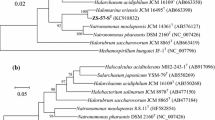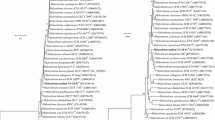Abstract
A halophilic archaeal strain, YGH94T, was isolated from the Yinggehai marine solar saltern near the Shanya city of Hainan Province, China. Cells of the strain were observed to be short rods, stain Gram-negative and to form red-pigmented colonies on solid media. Strain YGH94T was found to grow at 25–50 °C (optimum 40 °C), at 0.9–4.8 M NaCl (optimum 3.1 M), at 0–1.0 M MgCl2 (optimum 0.05 M) and at pH 5.0–9.0 (optimum pH 7.5). The cells were found to lyse in distilled water and the minimal NaCl concentration to prevent cell-lysis was determined to be 5 % (w/v). The major polar lipids were identified as phosphatidylglycerol, phosphatidylglycerol phosphate methyl ester and four major glycolipids (disulfated mannosyl glucosyl diether, sulfated mannosyl glucosyl diether and two unidentified glycolipids chromatographically identical to glycolipids in Halosimplex carlsbadense JCM 11222T). Strain YGH94T was found to possess two heterogeneous 16S rRNA genes (rrnA and rrnB) and both are related to those of Hsx. carlsbadense JCM 11222T (92.7–98.6 % similarities), Halosimplex pelagicum R2T (94.6–99.2 % similarities) and Halosimplex rubrum R27T (92.9–98.8 % similarities). The rpoB′ gene similarity between strain YGH94T and Hsx. carlsbadense JCM 11222T, Hsx. pelagicum R2T and Hsx. rubrum R27T are 95.4, 94.9 and 95.1 %, respectively. The DNA G+C content of strain YGH94T was determined to be 64.0 mol%. Strain YGH94T showed low DNA–DNA relatedness (35–39 %) with the current three members of the genus Halosimplex. The phenotypic, chemotaxonomic and phylogenetic properties suggest that strain YGH94T (=CGMCC 1.12235T = JCM 18647T) represents a new species of the genus Halosimplex, for which the name Halosimplex litoreum sp. nov. is proposed.

Similar content being viewed by others
References
Boucher Y, Douady CJ, Sharma AK, Kamekura M, Doolittle WF (2004) Intragenomic heterogeneity and intergenomic recombination among haloarchaeal rRNA genes. J Bacteriol 186:3980–3990
Cui H-L, Zhou P-J, Oren A, Liu S-J (2009) Intraspecific polymorphism of 16S rRNA genes in two halophilic archaeal genera, Haloarcula and Halomicrobium. Extremophiles 13:31–37
Cui H-L, Gao X, Yang X, Xu X-W (2010) Halorussus rarus gen. nov., sp. nov., a new member of the family Halobacteriaceae isolated from a marine solar saltern. Extremophiles 14:493–499
Cui H-L, Yang X, Mou Y-Z (2011) Salinarchaeum laminariae gen. nov., sp. nov.: a new member of the family Halobacteriaceae isolated from salted brown alga Laminaria. Extremophiles 15:625–631
De Ley J, Cattoir H, Reynaerts A (1970) The quantitative measurement of DNA hybridization from renaturation rates. Eur J Biochem 12:133–142
Han D, Cui H-L (2014) Halosimplex pelagicum sp. nov. and Halosimplex rubrum sp. nov., isolated from salted brown alga Laminaria, and emended description of the genus Halosimplex. Int J Syst Evol Microbiol 64:169–173
Huß VAR, Festl H, Schleifer KH (1983) Studies on the spectrophotometric determination of DNA hybridization from renaturation rates. Syst Appl Microbiol 4:184–192
Koh H-W, Song HS, Song U, Yim KJ, Roh SW, Park S-J (2015) Halolamina sediminis sp. nov., an extremely halophilic archaeon isolated from solar salt. Int J Syst Evol Microbiol (in press)
Kondo Y, Minegishi H, Echigo A, Shimane Y, Kamekura M, Itoh T, Ohkuma M, Takahashi-Ando N, Fukushima Y, Yoshida Y, Usami R (2015). Halorubrum gandharaense sp. nov., a novel alkaliphilic haloarchaeon from commercial rock salt. Int J Syst Evol Microbiol (in press)
Marmur J, Doty P (1962) Determination of the base composition of deoxyribonucleic acid from its thermal denaturation temperature. J Mol Biol 5:109–118
Minegishi H, Kamekura M, Itoh T, Echigo A, Usami R, Hashimoto T (2010) Further refinement of Halobacteriaceae phylogeny based on the full-length RNA polymerase subunit B′ (rpoB ′) gene. Int J Syst Evol Microbiol 60:2398–2408
Minegishi H, Echigo A, Kuwahara A, Shimane Y, Kamekura M, Itoh T, Ohkuma M, Usami R (2015a) Halocalculus aciditolerans gen. nov., sp. nov., an acid-tolerant haloarchaeon isolated from commercial salt. Int J Syst Evol Microbiol (in press)
Minegishi H, Echigo A, Shimane Y, Kamekura M, Itoh T, Ohkuma M, Usami R (2015b) Halococcus agarilyticus sp. nov., an agar degrading haloarchaeon isolated from commercial salt. Int J Syst Evol Microbiol (in press)
Oren A (2012) Taxonomy of the family Halobacteriaceae: a paradigm for changing concepts in prokaryote systematics. Int J Syst Evol Microbiol 62:263–271
Oren A (2014) Taxonomy of halophilic Archaea: current status and future challenges. Extremophiles 18:825–834
Oren A, Ventosa A, Grant WD (1997) Proposed minimal standards for description of new taxa in the order Halobacteriales. Int J Syst Bacteriol 47:233–238
Oren A, Arahal DR, Ventosa A (2009) Emended descriptions of genera of the family Halobacteriaceae. Int J Syst Evol Microbiol 59:637–642
Owen RJ, Pitcher D (1985) Current methods for estimating DNA base composition and levels of DNA-DNA hybridization. In: Goodfellow M, Minnikin DE (eds) Chemical methods in bacterial systematics. Academic Press, London, pp 67–93
Stackebrandt E, Goebel BM (1994) Taxonomic note: a place for DNA-DNA reassociation and 16S rRNA sequence analysis in the present species definition in bacteriology. Int J Syst Bacteriol 44:846–849
Tamura K, Peterson D, Peterson N, Stecher G, Nei M, Kumar S (2011) MEGA5: molecular evolutionary genetics analysis using maximum likelihood, evolutionary distance, and maximum parsimony methods. Mol Biol Evol 28:2731–2739
Ventosa A, Fernández AB, León MJ, Sánchez-Porro C, Rodriguez-Valera F (2014) The Santa Pola saltern as a model for studying the microbiota of hypersaline environments. Extremophiles 18:811–824
Vreeland RH, Straight S, Krammes J, Dougherty K, Rosenzweig WD, Kamekura M (2002) Halosimplex carlsbadense gen. nov., sp. nov., a unique halophilic archaeon, with three 16S rRNA genes, that grows only in defined medium with glycerol and acetate or pyruvate. Extremophiles 6:445–452
Zhang W-J, Cui H-L (2015) Halomicroarcula salina sp. nov., isolated from a marine solar saltern. Int J Syst Evol Microbiol (in press)
Acknowledgments
This work was supported by the National Natural Science Foundation of China (No. 31370054), the 11th “Six Talents Peak” Project of Jiangsu Province (No. 2014-SWYY-021), the Qinglan Project of Jiangsu Province and a project funded by the Priority Academic Program Development of Jiangsu Higher Education Institutions (PAPD).
Author information
Authors and Affiliations
Corresponding author
Electronic supplementary material
Below is the link to the electronic supplementary material.
Rights and permissions
About this article
Cite this article
Yuan, PP., Xu, JQ., Xu, WM. et al. Halosimplex litoreum sp. nov., isolated from a marine solar saltern. Antonie van Leeuwenhoek 108, 483–489 (2015). https://doi.org/10.1007/s10482-015-0501-8
Received:
Accepted:
Published:
Issue Date:
DOI: https://doi.org/10.1007/s10482-015-0501-8




